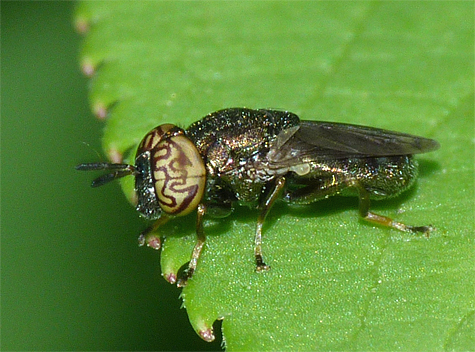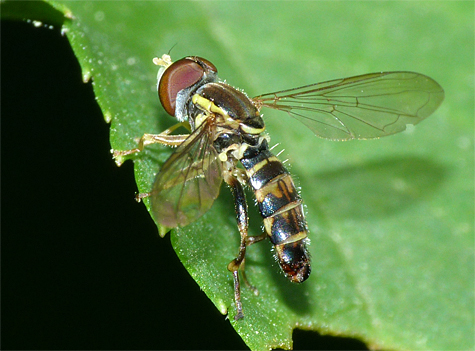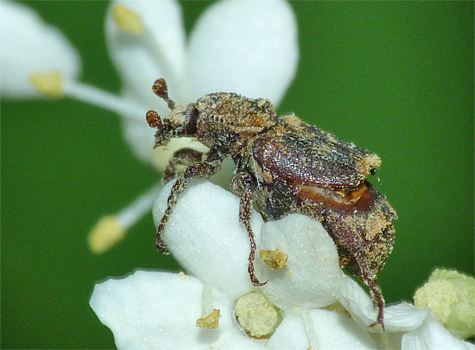
As I mentioned in a previous post, I was photographing elderberrry earlier in the month (which has since gone by) and came across some interesting insects. The Mocha Emerald in that post was one of them. The tiny fly above was another.
I didn’t know what the fly was at the time and thought perhaps that the pattern on its eyes was caused by the flash on the camera, I thought that maybe the pattern was caused by some internal “hotspots” within the eyes. Not so. I uploaded the photo to BugGuide and within minutes I received two replies as to what this little gem was.
It’s a syrphid fly. Syrphid flies are familiar to most people as those little flies that look like bees (yellow and black or brown) and hover about the garden while busily visiting flowers. They sometimes hover in front of your face. I call them hoverflies. Their wings usually make quite a bit of noise for a their size which adds to the illusion that they are bees. They can be from 1 to 35 mm long.
The little (about 5 mm) fly in the photo is the only syrphid fly in the east with this unusual zig-zag pattern on its eyes and is known as Orthonerva nitida. I haven’t found a common name for the fly but if anyone can break down the scientific name let me know what you come up with. It looks to me to be straight (ortho), Roman Emperor (Nerva – an honest, kind emperor) for the genus part of the name and shiny or bright (nitida) for the species name. That doesn’t make sense though, does it? Maybe the straight part comes from the fact that flies in this genus, unlike its relative below, hold their wings straight back to the rear, on their backs?
Two other insects that I noticed that day were another, more typical, syrphid fly and a beetle.


I thought at first that the insect in the above photo was a weevil. I’m now fairly convinced that its a beetle, a scarab beetle in the genus Valgus. Note that the elytra (el-i-truh – the hard forewings which cover the membranous flight wings) are very short on this insect, a characteristic of Valgus beetles. But, I could be wrong. Any experts out there?
Greg, is this the same camera I asked about in the prior post? If so, I need one!! Great quality!
Indeed it is the same camera, Ashlyn. Those images were blown up some and even manipulated a tad. I do have an attachment which allows fairly extreme close-ups, but sometimes its better, and easier, to shoot now and enlarge later.
Thanks,
Great pics Greg! I love all the Batesian mimicry in the insects.
Hey Larry!
Yes, there are quite a few insects running and flying about that look and even behave like their often more dangerous cousins. What would truly be interesting is that if these mimics knew that they were mimicking other insects and actually learned the behavior of their model insects. I’m sure that its not intentional though, after all, they were born that way (or, rather hatched) and had no choice in the matter as to what they look like. I believe, however, that I read something about certain ants that take on the behavior or smells of their enemies in order to infiltrate their nests. I guess that may fit under a different heading though, wouldn’t it.
Thanks, Larry.